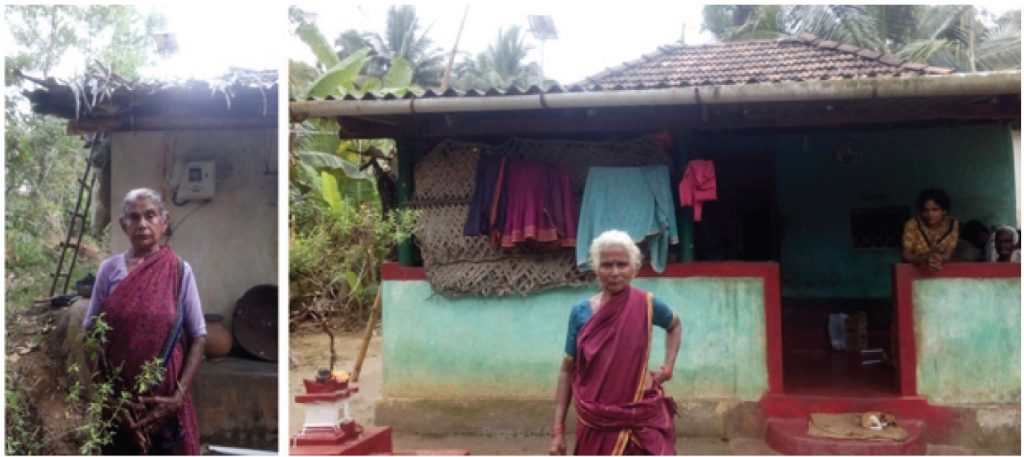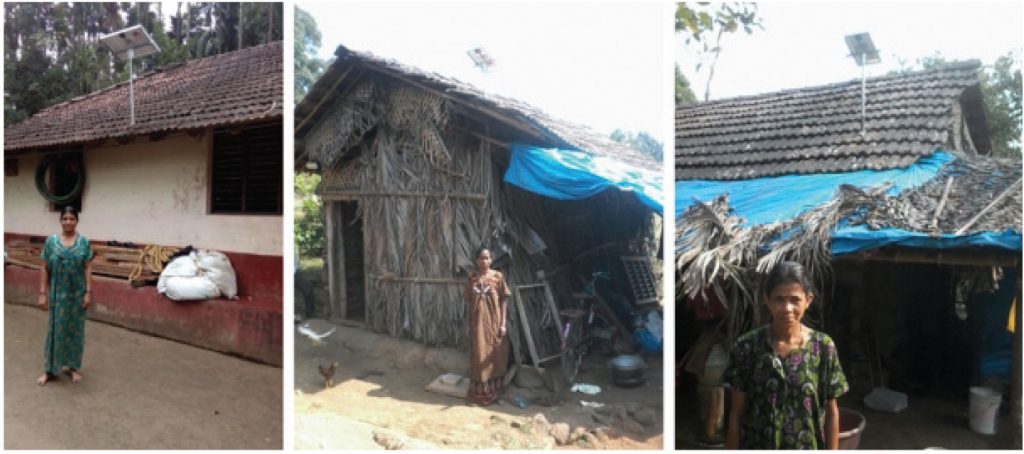Providing energy access to rural India is not an easy task. Selecting villages with willing and able stakeholders, offering the right solutions, and nurturing partnerships amongst various stakeholders are of paramount importance.
Amasebail village in Kundapura taluk in Udupi district of south Karnataka is well on its way to becoming a 100 per cent solar-powered village with all street lights in the area running on solar energy and individual homes installed with solar-powered lighting systems. The village is now being used as a model to be replicated in other parts of the state.
The Amasebail gram panchayat covers three villages – Amasebail, Rattady and Machattu – with a total of 1,850 households (as of 2016) across all income strata. Earlier, all the houses in the village either had no electricity or were facing issues pertaining to an unreliable grid, leading to a loss of income for those dependent on power for their livelihood. In addition, many households, especially poor ones, could not deploy solar systems because of lack of access to affordable financial products.
In 2008, A.G. Kodgi, former MLA and chairman of Karnataka’s Third State Finance Commission, announced the formation of the Amasebail Charitable Trust for the purpose of initiating development works and welfare projects in Amasebail village. The Trust estimated an expenditure of Rs 500 million over a period of five years to realise the goal of making Amasebail a model panchayat. Karnataka Bank, the Amasebail Gram Panchayat, the Sri Kshetra Dharmasthala Rural Development Project (SKDRDP), the Navodaya Charitable Trust, the Kodgi Trust, local cooperative societies, philanthropists and local area development funds financed the project. At present, Kodgi is the president of the trust.
Key stakeholders
Bengaluru-based for-profit social enterprise SELCO Solar sold 50 systems in this area in 2002 through Amasebail Cooperative Bank. SELCO kept a deposit with the bank and compensated part of the interest on loans by the end users. The availability of doorstep services and the presence of local technicians led end users to show faith in SELCO.
The gram panchayat introduced SELCO to the Trust to help facilitate their proposal through the government’s e-procurement route to the Ministry of New and Renewable Energy (MNRE) and Karnataka Renewable Energy Development Limited (KREDL).
A unique step taken at this stage was the formation of a public-private solar implementation committee, which consisted of members from the Trust, SELCO, and the gram panchayat and district administration. The committee played an advisory role for the complete planning and execution of the project.
The proposal for powering the village of Amasebail with solar lighting systems was drafted by the committee in consultation with SELCO, and submitted to the MNRE and KREDL in 2012. Repeated follow-ups by the alliance helped the project come to fruition in 2016. In terms of financing, KREDL’s contribution was 20 per cent and the MNRE’s was 30 per cent, while the district office and others provided the balance. The proposal mentioned the expected energy savings, the carbon impact, savings per month, etc. It also highlighted the area’s need for reliable power and role of solar energy in employment creation, education, etc.
SELCO, selected through the e-tendering process, was entrusted with the work of installing individual home lighting systems including solar panels, tubular batteries, charge controllers, LED lights and mobile charging points. The e-tender process also included a significant after-sales commitment, which is an important point to keep in mind with reference to how a good e-tender needs to be drafted. As per the tender conditions, the company has provided a guarantee of five years for the solar lamps, under which it will undertake half-yearly maintenance and replace faulty lamps.
Best practices
For providing energy access solutions in rural areas, these are some common best practices to be followed while submitting proposals to the government for funding support:
- Selection of villages in a district is the first step. It is best to choose either a well-performing panchayat or a relatively active panchayat. This will demonstrate reasonable success in the early days itself.
- Ascertain the requirements of villagers. In the case of Amasebail, it was the need for decentralised sustainable energy to improve livelihoods with user buy-in and ownership, which is the most sustainable form of energy access.
- After panchayat selection, the lead implementation partner should discuss the need, approach, funds to be leveraged, beneficiary contribution, and local buy-in (amount from local institutions, households availing of solar energy, panchayats, local NGOs, trusts, etc.), with all stakeholders.
- The role of other partners is also critical. There should be 5-10 local partners, preferably involving the panchayat, to map overall demography, identify special considerations and income levels, and list public institutions, schools, industries, street lights, water sources, etc. in the area.
Once the partners are established, the next step is to write the proposal for converting the village into a self-sustainable village. This is followed by the collection of data.
A registered local body/panchayat or trust seeking funding can register on the government portal. In the case of Amasebail, the Trust registered itself on the e-procurement portal.
Then the proposal needs to be sent from the district office/local panchayat to the respective funding sources. If government funds are being leveraged, there may be a tender process. In the case of Amasebail solar project, the district office recommended applying through e-procurement via the MNRE/KREDL tender. Local partners may be aware of other funding sources such as employment generation agencies, women empowerment funds, social welfare funds, funds for micro, small and medium enterprises, and gram udyog funds, or public or private sector corporate social responsibility (CSR) funds.
Once the proposal is sent, it could take at least two to five years with major follow-up till completion. Amasebail took four years from the time the proposal was sent.
During the wait for fund allocation, there is a possibility of people coming forward and purchasing solar via local financing. For instance, while waiting for the MNRE/ KREDL funding, due to the awareness created about solar, many households came forward and purchased solar by availing of financing from local financial institutions. In addition, several institutions, including temples and schools in the village, installed solar systems. Thus, during 2012-16, SELCO set up 250 solar systems in the village.
The most critical factor for the success of the project is the project lead. The lead must have a vision, along with patience, passion and the ability to build relationships. An individual, an enterprise or an organisation could execute the project.
Innovative partnerships and approach
So how many stakeholders does it take to leverage government funding for powering households in a village? Five: a village panchayat committed to sustainability; a local village trust that works in the interest of the local community; a committed enterprise with a strong after-sales service network; a rural bank and a microfinance institution that has the risk appetite to finance remote systems; and end users who believe in deploying long-term sustainable solutions for meeting their power needs.
In Amasebail, the partnership of the district administration, the gram panchayat, the Amasebail Charitable Trust, Karnataka Bank, SKDRDP and SELCO was critical for the implementation of the project, with all having equal stakes in the success of the project. The innovation was a combination of technology, finance and delivery mechanisms. The availability of local finance along with contribution from the local government led to a new collaboration between the state and individual households. The critical involvement of each stakeholder thus ensured the social and financial sustainability of the project.
Economic benefits and impact
The monthly payments were equal to the amount that individual households were spending on kerosene and other fuels for their lighting and mobile charging requirements. The project was economical not only for individual households, but also for the government, if one factors in the external costs of coal-fired power plants that would be needed to generate the same amount of electricity for 1,497 households.
The Amasebail village has more than 2,000 school-going children who have been directly impacted by the solar home lighting systems. No longer do they have to strain their eyes and suffer from studying under dirty and smoky kerosene lamps. There has been a marked improvement in the education of these children, leading to better attendance in schools.
Moreover, these households now have an extra four hours in the evening for other activities, which has led to many of them adopting other forms of livelihood like weaving and sewing, and thus increased incomes.
Hundreds of villages across the world are unelectrified and governments usually plan expensive fossil fuel-based plants to power these villages. Such options are environmentally harmful. While there are many small-scale decentralised renewable energy projects comprising a few households using solar, villages such as Amasebail with more than 1,400 houses powered by solar and financed by local banks are unique. The scale of this project has made it economical for the local government and the people of this village. It is hoped that other villages will emulate this model.
SELCO is moving forward to replicate this project in other villages by preparing proposals for tapping funds and building similar ecosystems as in Amasebail. In fact, some villages have started sending out proposals for developing solar villages through the e-procurement route. The Kotapattu panchayat sent a proposal to the MNRE in 2017, while Perebe village is in the process of implementing a solar village project, and has set up a solar implementation committee consisting of a local trust and the panchayat, among others.





